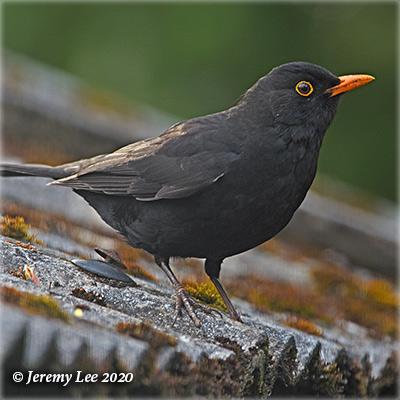
 |
|
Scientific Classifications explained » Amphibians » Ants » Aphids » Bees » Beetles » Birds » Bugs » Butterflies » Caterpillars » Damselflies » Dragonflies » Earwigs » Flies » Frog/Leafhoppers » Fungi » Galls » Grasshoppers » Harvestmen » Hoverflies » Lacewings » Ladybirds » Leaf Mines » Lichens » Mammals » Millipedes » Mosses » Moths » Sawflies » Slugs » Snails » Spiders » Trees » Wasps » Wild Flowers » Woodlice |
UK Nature > Birds > Turdus merula

Scientific Name: Turdus merula Common Name: Blackbird Turdus merula, more commonly known as the blackbird, is approximately 25cm in length. The male (pictured) is jet black with a bright yellow bill and eye ring; the female is a medium brown colour with some spotting on the breast and a brown bill. Their song is rich and melodious, almost flute-like, with a variety of phrases, and the commonest call heard is a loud "pink-pink-pink", uttered when the bird is alarmed for some reason. Blackbirds are omnivorous, taking worms, insects and other invertebrates as a matter of course, but they love fruit and will often visit bird tables for kitchen scraps. Their nest is a cup made with grass and other plant material, lined with mud and then with fine grass and other soft materials; usually built by the female in dense vegetation, often in honeysuckle or ivy. Can be found almost anywhere in the UK with trees and bushes; one of our commonest and most visible birds and present in almost every garden in every town. |
|

https://www.uknature.co.uk is a website dedicated to showing the immense diversity of UK nature and wildlife. Our vast range of habitats, from lowland arable to snow covered mountains, from storm-ravaged coastlines to peaceful inland freshwater lakes and rivers, from dry, sandy heaths to deciduous and coniferous forests, all these habitats contribute to the abundance of UK nature. We have wild birds in huge numbers either residing or visiting our shores (597 recorded species as at July 2013) and we must also not forget the humble back garden with its grass lawns, flower beds filled with nectar rich flowers, shrubs and trees, all designed to attract huge numbers of insects such as bees, moths, butterflies and hoverflies; and finally the small ponds which provide safe havens for frogs, toads, newts and even slow worms and grass snakes. www.uknature.co.uk is the showcase for my personal passion, photographing uknature in all its glory. I sincerely hope you all enjoy the fruits of my labours. This site and all images contained therein is © Jeremy Lee 2004 - 2021. All Rights Reserved. Site design by Jeremy Lee. Site development & IT Support by Stuart Lee. |